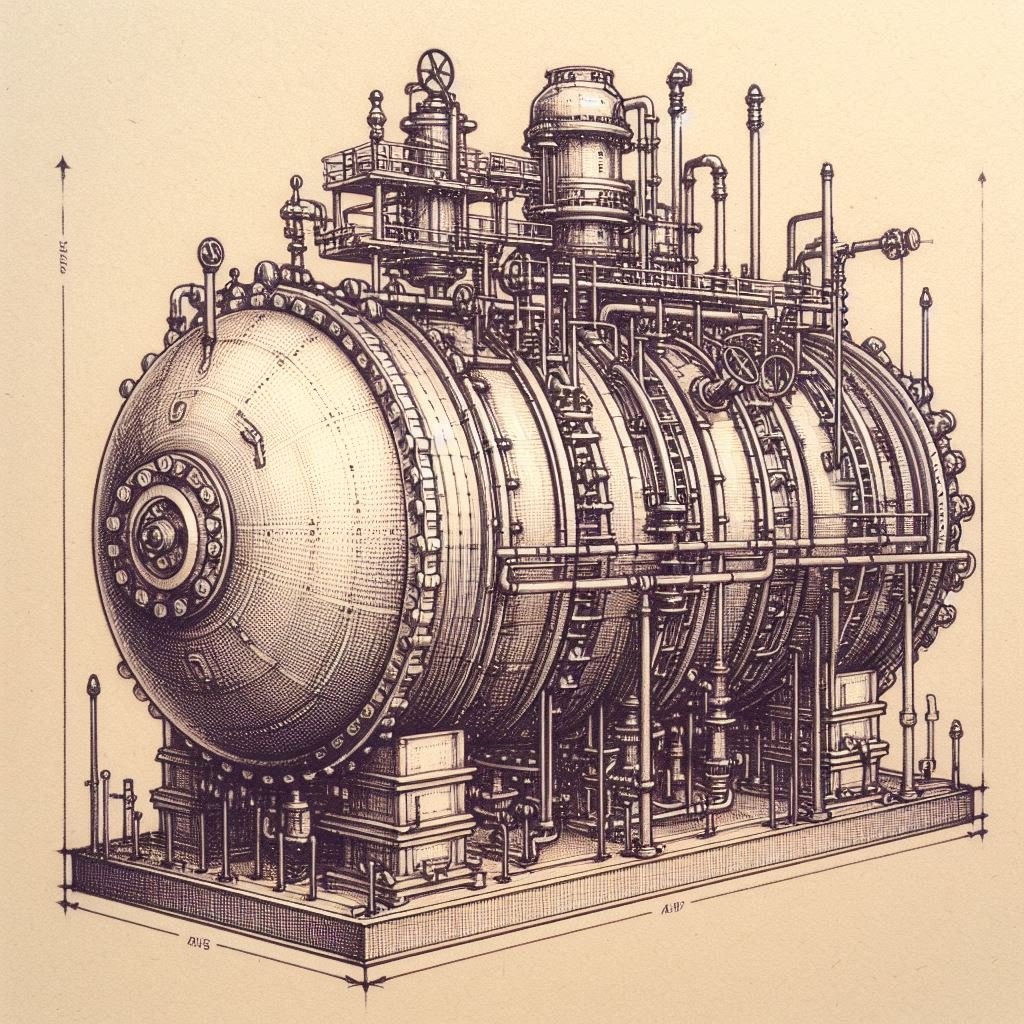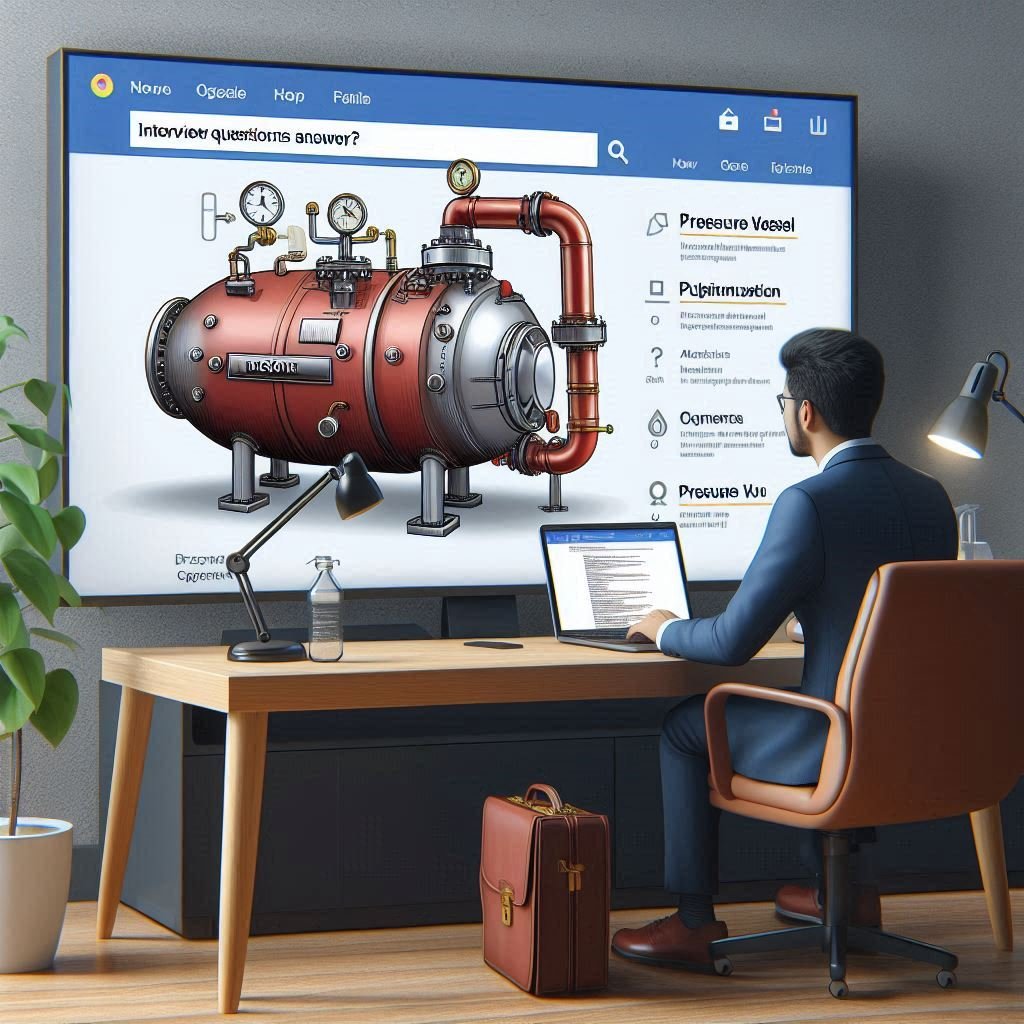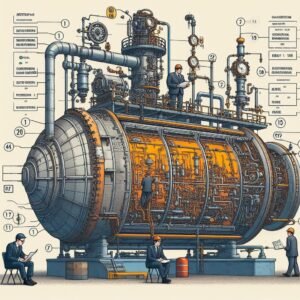Introduction to ASME Pressure Vessels:
When it comes to the fabrication, inspection, and certification of ASME pressure vessels, understanding the detailed requirements and procedures outlined by the American Society of Mechanical Engineers (ASME) is crucial. ASME’s rigorous standards ensure the safety, reliability, and efficiency of these vessels, which are widely used in various industries, including petrochemical, power generation, and manufacturing. This blog aims to address some of the frequently asked questions related to ASME pressure vessels, covering topics such as inspection responsibilities, hydrostatic test pressures, post-weld operations, and material traceability. Whether you are an engineer, inspector, or manufacturer, this comprehensive guide will help you navigate the complex landscape of ASME code requirements and best practices, ensuring compliance and quality in pressure vessel construction and maintenance.

1. For ASME Pressure vessel, does witnessing and signoff of required tests by the authorized inspector relieve the client’s inspector of the responsibility to witness those tests?
Answer: No, witnessing and signoff by the authorized inspector does not relieve the client’s inspector of the responsibility to witness those tests.
2. As a rule of thumb, how hydrostatic test pressures are calculated for ASME Pressure Vessels?
Answer: 1 1/2 times design pressure.
3. TRUE or FALSE: After stress relieving operations have been completed, major repair welding is permitted with the authorized inspector’s concurrence.
Answer: TRUE.
4. When hydro testing an ASME Pressure vessel with a test pressure of 5000 PSIG, what is the preferred pressure range for the test gage utilized?
Answer: 10,000 PSI (Generally, the test gauge should be capable of measuring at least twice the test pressure.)
5. When inspecting longitudinal welds of individual courses, how can peaking be corrected?
Answer: Peaking can be corrected by applying local heating and using jacks to relieve the stress and reshape the vessel.
6. Does ASME VIII require traceability of welds to the welder who performed the weld?
Answer: Yes, ASME VIII requires traceability of welds to the welder who performed the weld.
7. Does ASME require a hydrostatic or pneumatic test on all ASME Pressure vessel?
Answer: ASME requires a hydrostatic test on all vessels, unless specifically exempted.
8. Give an example of weld encroachment.
Answer: Weld encroachment occurs when a weld extends onto the base metal beyond the specified limits, affecting the integrity of the joint.
9. Does ASME require a welder who just does fit-up tack welding to be qualified?
Answer: Yes, ASME requires qualification of welders for fit-up tack welding as well.
10. Does ASME allow the use of welders not employed by the manufacturer?
Answer:Yes, ASME allows the use of welders not employed by the manufacturer, provided they are qualified.
11. Does ASME allow peening to relieve stresses or to improve weld quality?
Answer: Yes, ASME allows peening for both purposes.
12. Does ASME Section VIII Division 1 requires personnel performing radiographic examinations to be qualified in accordance with what American National standard?
Answer: Personnel performing radiographic examinations must be qualified in accordance with SNT-TC-1A (American Society for Nondestructive Testing Recommended Practice).
13. Acceptance criteria for radiographs procedures shall be:
Answer: SNT-TC-1A (American Society for Nondestructive Testing Recommended Practice).
14. How does a Certificate of Compliance differ from a CMTR?
Answer: A Certificate of Compliance certifies that the materials meet the required specifications and standards, while a CMTR (Certified Material Test Report) provides detailed test results and chemical composition of the materials.
15. Is any specific NDE required for Stainless Steel vessels greater than 3/4 inch thickness?
Answer: Yes, for stainless steel vessels greater than 3/4 inch thickness, Radiographic Testing (RT) is typically required.
16. What U.S. Industry standard is used in the construction of unfired pressure vessels?
Answer: The U.S. industry standard used in the construction of unfired pressure vessels is ASME Section VIII.
17. What requirements does ASME VIII Division 2 contain?
Answer: ASME VIII Division 2 contains alternative rules to Division 1 for the design and construction of pressure vessels, specifically for vessels subject to high pressures or other unique conditions.
18. What are joint categories and how are they used?
Answer: Joint categories classify the type and quality of joints used in welding, helping to determine the required welding procedures and qualifications.
19. What is joint efficiency?
Answer: Joint efficiency is a factor used to account for the strength of different types of joints in pressure vessel design calculations.
20. TRUE or FALSE: ASME Section VIII, Div. 1, UCS-56 lists the requirements for post weld heat treatment.
Answer: TRUE.
21. TRUE or FALSE: ASME VIII, Div. 1, UCS-193 lists the requirements for standard hydrostatic tests?
Answer: FALSE.
22. What is NACE MR0175?
Answer: NACE MR0175 specifies the requirements for materials resistant to sulfide stress cracking in sour environments.
23. According to NACE MR0175 what is the normal maximum hardness of carbon and low alloy steels exposed to sour service?
Answer: The normal maximum hardness is 22 HRC (Rockwell C).
24. In addition to hardness testing, what is the other main requirement in NACE MR0175?
Answer: The other main requirement is testing for sulfide stress cracking resistance.
25. A welder is proposed for welding SMAW on an ASME pressure vessel. The qualification test was done 3 years previously, but the manufacturer can show that the man had been welding with the SMAW process up to 11 months ago. Is this acceptable?
Answer: Yes, this is acceptable. ASME allows the use of prior experience as proof of recent activity for qualification renewal.
26. For a pressure vessel being built according to ASME, what is the governing specification for welding?
Answer: The governing specification for welding is ASME Section IX.
27. Welding on a low temperature pressure vessel, which of the following are important?
Answer: Interpass temperature, preheat temperature, and calibration of welding machine are all important for welding on low temperature pressure vessels.
28. If a deviation from the specification is noted by the client inspector, who should be informed?
Answer: The client inspector should inform the Authorized Inspector.
29. If a deviation from a client requirement is noted, who may approve it?
Answer: Deviations from client requirements may be approved by the client themselves, depending on the agreement and nature of the deviation.
30. In the ASME code, the Inspector referred to is the:
Answer: National Board qualified inspector.
31. The manufacturer of a pressure vessel built to ASME VIII Div. 1, must have a formal quality system meeting the requirements of:
Answer: ISO 9001 (ASME requires compliance with ISO 9001 for quality management systems.)
32. A manufacturer is fitting up a large bore nozzle in a pressure vessel. Give at least 8 points the inspector should typically inspect/monitor/check.
Answer: Here are some points the inspector should typically check:
- Fit-up of the nozzle to the vessel.
- Alignment of the nozzle.
- Weld preparation and cleanliness.
- Edge preparation if welding.
- Welding procedure qualification.
- Welder qualification.
- Preheat temperature and control.
- Welding process parameters.
- Non-destructive testing (NDT) of the weld.
- Post-weld heat treatment (if required).
- Dimensional checks after welding.
- Surface finish and inspection for defects.
33. Is it acceptable to carry out a hydrostatic test after the primer coat of an ASME Section VIII, DIV. 1 pressure vessel is applied?
Answer: Yes, it is acceptable to carry out a hydrostatic test after the primer coat is applied, provided the coating is compatible and does not interfere with the test.
34. In the case of a pressure test of an austenitic stainless steel pressure vessel, what is the critical difference to be considered when compared with a carbon steel vessel?
Answer: The critical difference is the potential for sensitization and stress corrosion cracking in austenitic stainless steel vessels, which requires careful consideration during testing.
35. What is the optimum pressure gauge to use for a test of a pressure vessel at 4,000 psi?
Answer: 0 – 5,000 psi (The gauge should cover the test pressure with some margin.)
36. Is a hydrostatic pressure test required for all ASME VIII Div. 1 pressure vessels?
Answer: Yes, a hydrostatic pressure test is generally required for all ASME VIII Div. 1 pressure vessels, unless specifically exempted.
37. What does MDMT stand for in connection with a pressure vessel?
Answer: Minimum Design Metal Temperature (MDMT) is the lowest temperature at which the material of the pressure vessel can safely operate under the specified design conditions.
38. TRUE or FALSE: The requirement for ‘spot RT’ means that 10% of all welds must be radiographed.
Answer: TRUE.
39. After cutting-back the cladding of a clad plate vessel, what test is required before welding an internal attachment?
Answer: Visual inspection and possibly ultrasonic testing (UT) or radiographic testing (RT) are required before welding an internal attachment.
40. TRUE or FALSE: When an Authorized Inspector accepts a deviation to the Code, no further action is required by the third party inspector.
Answer: FALSE. Further action may still be required depending on the nature and significance of the deviation.
41. Name 2 items that should be stamped on a plate that will be used to fabricate a pressure vessel.
Answer: The plate should be stamped with:
The plate should be stamped with:
- Material identification (e.g., material grade, heat number)
- Heat treatment information
42. Why are plate edges inspected prior to welding?
Answer: Plate edges are inspected prior to welding to ensure they are clean, free from defects (such as cracks or laminations), and prepared according to the specified joint configuration (e.g., beveled edges for welding).
43. TRUE or FALSE: It is possible for a forging to have the required reinforcement as an integral part of the forging, rather than a separate reinforcing plate.
Answer: TRUE. Forgings can be designed with integral reinforcements, which can sometimes replace the need for separate reinforcing plates.
44. Why is it a good practice to do a visual inspection prior to final PWHT?
Answer: Visual inspection prior to final Post Weld Heat Treatment (PWHT) ensures that all welds and components are in good condition before they undergo the thermal stress of PWHT, reducing the risk of defects or failures.
45. TRUE or FALSE: It is acceptable to perform the final code acceptance hydrostatic test after PWHT.
Answer: TRUE. It is acceptable to perform the final code acceptance hydrostatic test after PWHT, provided that all other required examinations and inspections have been completed satisfactorily.
46. Which NDE methods are commonly used to inspect the integrity of stainless steel strip lining?
Answer: The commonly used Non-Destructive Examination (NDE) methods for inspecting the integrity of stainless steel striplining include:
- Ultrasonic Testing (UT)
- Liquid Penetrant Testing (PT)
- Radiographic Testing (RT)
47. Regarding vessel heads, what does the term “F & D” stand for?
Answer: The term “F & D” stands for Flanged and Dished. This refers to a type of vessel head that is both flanged (has a rim or lip) and dished (curved into a shallow bowl shape), providing structural strength and resistance to internal pressure.
48. What is the ASME IX “P” number of A516 grade 70 plate?
Answer: The ASME IX “P” number for A516 grade 70 plate is P-No. 1. This classification helps in grouping materials with similar weldability and characteristics.
49. ASME Section VIII generally permits vessels to be out-of-round by:
Answer:1% of the average of the maximum and minimum diameters.
50. What document does ASME VIII require for a two-piece head that was weld fabricated by another company?
Answer: ASME VIII requires a Material Test Report (MTR) or a Certificate of Compliance for a two-piece head that was weld fabricated by another company. This document certifies that the material and fabrication processes meet the required standards.
51. What letter describes the Code stamp for a newly fabricated ASME VIII, Div. 1 pressure vessel?
Answer: The letter that describes the Code stamp for a newly fabricated ASME VIII, Div. 1 pressure vessel is “U”.
52. On an ASME VIII, Div. 1 pressure vessel, what do letters/numbers “RT 1” on a nameplate mean?
Answer: The letters/numbers “RT 1” on a nameplate of an ASME VIII, Div. 1 pressure vessel indicate that 100% radiographic testing has been performed on all pressure-retaining welds.
53. TRUE or FALSE: On ASME VIII, Div. 1 pressure vessels, minor repair welds after hydrostatic are permitted.
Answer: TRUE. ASME VIII, Div. 1 permits minor repair welds after hydrostatic testing, provided they meet specified criteria and are inspected according to the Code.
These answers cover the remaining questions comprehensively. If you have any more questions or need further clarification, feel free to ask!
Refer to the blog to find basic mechanical questions generally asked during Mechanical Interview.









Hello, I found this blog via google, just thought you might want to know!